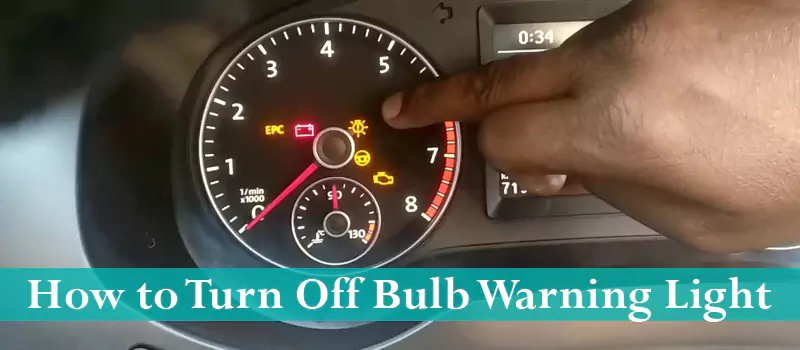Many modern cars come with pre-installed monitoring tools to assist drivers to figure out exactly what error may be happening with the car.
A specifically common one is car dashboard lights that indicate general issues with the car such as with the engine or bulbs.
Bulbs play a significant role for cars as signals for brakes, turn signals, and headlights. This means any driver should be aware of what bulb warning lights are, what they mean, and how to turn off bulb warning lights.
Bulb warning lights may indicate an error with a circuit or mean you need to replace a bulb that may be dead.
A bulb warning light may show you specifically which bulb or you may have to do a thorough check of the bulbs around your car to figure out where the issue is.
Until the issue is located and fixed, the bulb warning light will continue to show on your dashboard.
To turn off bulb warning lights, there are a few steps that will have you on your way.
5 Steps to Turn Off Bulb Warning Light:
Step 1: Look for Bulb-out Warning Light
The first thing a driver should look for is a bulb-out warning light on their dashboard. If you have it showing on your dashboard, then it may indicate that you may need to replace the bulb of one of your lights.
Some vehicle models offer a generic light bulb warning light showing that there is a bulb issue.
More sophisticated cars have tools to show exactly what bulb may have an issue for example the turn signal bulb.
If your car is not so sophisticated, you have the option to buy monitoring hardware that will specifically identify which light on your car may have a problem so that you can waste less time trying to figure out which one.
Step 2: Locating the Bulb Issue
If the car owner is not sure of the bulb with an issue, a thorough check of all the car bulbs will help you identify what may need fixing. This may include checking brake lights, turn signals, headlights, and fog lights.
Once the lights on the car with a problem are identified, you will need to check whether it is the bulb or circuit that may have signaled the warning light. Once the actual problem is identified, it is easy to figure out how to fix it.
Step 3: Options for Fixing the Bulb Issue
Fixing the light bulb or circuit can be done personally or by scheduling a service appointment with experts who will do it for you. It may need a bulb or circuit replacement.
If you do it yourself, you will have to unplug the bulb to replace it with a new one.
After fixing or replacing the bulb or circuit, the car computer will turn off the bulb error light or turn the bulb failure warning light off.
There are instances where the suggested fixes may not turn off these lights. This may mean you may need to reset the car computer.
Step 4: The Bulb Warning Light Did Not Turn Off
If the car computer fails to turn off the bulb error light after you have fixed any of the issues with the lights, it may need a reset. Resetting the bulb out warning light will need you to loosen the negative terminal of your battery.
This will disconnect the power to your computer.
After disconnecting power to your computer, you will need to leave this for about ten minutes to reset the light bulb warning light.
Step 5: Resetting the Car Computer
Once the ten minutes have passed, retighten the negative terminal. Once the computer is back on, check whether the warning light bulb reset. If it resets, it will turn the bulb failure light off.
Related Guides:
Are All Your Warning Lights ON?
While bulb warning lights are important to understand, there are times when you may have a flare-up of all warning lights of your vehicle.
Many may think this is a cause for concern and they are right. Any driver should take precautions to figure out what may be causing all their lights to go off.
The biggest suspected cause of this malfunction is the electronics of the car. Some car experts call this issue intermittent.
It is an electrical issue that if ignored can have dire consequences for the car or the driver which means it should be dealt with urgently. It could lead to fire, death, or harm to vital components of the car computer.
Rectifying this issue requires that the fuse box or battery connections be checked. It is important to make sure that they are operating appropriately to ensure warning light removal.
Alternatively, rather than checking the car yourself, it may be best to get your car checked by a trusted mechanic.
Conclusion
Bulb warning lights assist car owners to detect issues with bulbs and circuits that you probably will not notice by yourself. It allows drivers to focus on driving while it takes care of the monitoring.
Occasionally, bulb warning lights will go off. Drivers need to be aware of what they mean and understand how to fix the issues they indicate.
Some cars make it easier to know where the actual bulb problem is while others require a thorough inspection to establish what the issue is.
As a regular driver, it is important to take note of not just bulb warning lights but any other lights that come up on your dashboard.
These may be useful in ensuring you have the safest journey with the least mechanical car issues.
Whether it is an indicator of an engine or the bulb issue, warning lights are one of the auto world’s greatest, convenient and problem-solving inventions that every driver should understand.

